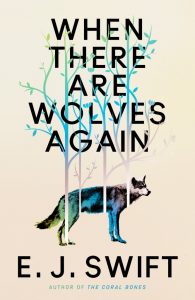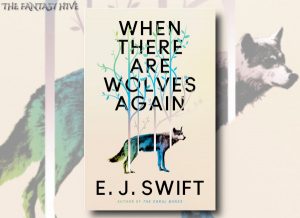WHEN THERE ARE WOLVES AGAIN by E. J. Swift (BOOK REVIEW)
“Like Chornobyl rain, an event has to touch you to register. Lux is your proof that you had to come here, to the end, in order to being. And you know that the story you have told yourself for so many years must also end here. Lux has a full life ahead, and you both must live it.
From now on, you will tell the stories of those who push back against disaster, who look to the light.
You will tell the stories of those whose language cannot be read.
You will become the cypher.”
Long-time readers will know that I am a huge fan of E.J. Swift’s marvelous writing. A particular favourite of mine is her devastating eco-fiction short story ‘The Endlings Market’ from Unsung Stories’ superlative 2084 anthology (2017). So I was already super excited to read her latest novel, When There Are Wolves (2025). But when I found out about halfway through that it’s an expansion of/spiritual successor to ‘The Endlings Market’, I was utterly delighted. With When There Are Wolves Again, Swift builds on the promise of that short story to deliver one of the most beautiful and urgent novels of the year. The novel is a profoundly moving exploration of our relationship to nature in an era of rapid climate change. It unsentimentally warns us that there are hard times ahead, but still manages to wrest a hard-won hope from the dismal realities facing us. When There Are Wolves Again is speculative fiction at its very best, and if it doesn’t put Swift on the nominations for all the awards in the coming year you bet I’m throwing a hissy fit.
 Hester is a documentary filmmaker. She was born on the day of the Chernobyl explosion, and finds herself liberated when she visits the plant in 2021 to film a documentary about its feral dog population. She finds and rescues a wolf-dog pup who she names Lux, and the encounter inspires her to spend her life documenting the effects of the climate crisis on nature. Lucy is an activist, who bonds with her grandmother during covid over their shared love of birds, and is inspired to spend her life campaigning for climate justice and land rights. Bookended by scenes of the two women meeting around a campfire in the Cairngorms in 2070, the novel explores the lives of these two women as they experience firsthand the rising temperatures, the mass extinctions, and the radical changes in land use that shape these decades.
Hester is a documentary filmmaker. She was born on the day of the Chernobyl explosion, and finds herself liberated when she visits the plant in 2021 to film a documentary about its feral dog population. She finds and rescues a wolf-dog pup who she names Lux, and the encounter inspires her to spend her life documenting the effects of the climate crisis on nature. Lucy is an activist, who bonds with her grandmother during covid over their shared love of birds, and is inspired to spend her life campaigning for climate justice and land rights. Bookended by scenes of the two women meeting around a campfire in the Cairngorms in 2070, the novel explores the lives of these two women as they experience firsthand the rising temperatures, the mass extinctions, and the radical changes in land use that shape these decades.
When There Are Wolves Again is a wonderful demonstration of how the personal is political. Both Hester and Lucy’s work is deeply politically engaged, so their perspective allows Swift to focus on the fallout of climate change in a way that other characters might not. Thus, we get to see the subjects of Hester’s various film projects, from rewilding projects that are reintroducing beavers to the UK to clashes of protesters over farmland use. And we also see Lucy’s protests, from her early childhood marches inspired by Greta Thunberg to her project to recommon Balmoral after it is controversially bequeathed to the public by a dying King Charles. But Swift reminds us that the perspectives of these women are inevitably shaped by their lived experience, the political emerging from the shape their personal lives have taken. Hester grew up on a farm in Somerset, and her family have a very traditional idea of stewardship of the land which conflicts with the rewilding projects that fascinate Hester. Her decision to leave the farm and abandon her family’s traditional way of life shapes her relationship with her family, particularly her brother who stays on to look after the farm, which itself informs her relationship to the UK’s changing landscape and the arguments taking place about how they should be managed through climate crisis. Similarly, Lucy is shaped by her relationship to her grandmother, who nurtures both her love of nature and her burgeoning sense of political responsibility, in contrast to her conservative parents who see what she’s doing as “woke nonsense”. As Lucy comes of age and becomes politically engaged, she sees activism as a necessary response to the inaction and lack of foresight of her parents’ generation, and as she grows and matures we see how her political engagement reflects her love of nature, and how the two of them help her through dark and dangerous times.
When There Are Wolves Again is a novel of hope, but it is a hope that is hard-won. Lucy and her activist friends, and Hester’s moving and informative artworks, represent a positive way of engaging with the changing world and influencing it for the better, for both the human and the non-human. But this is countered by the ever-present threat of far right nationalism, represented by the Albion Party, who respond to the changing times with fear, hatred and violence. There are also the rich people who, instead of investing their money in something useful, are using it to hunt down the last remaining individuals of dying species so they can display them in their macabre collections, the Endlings market of Swift’s previous short story. So while the novel offers hope, Swift does not shy away from exploring the monstrous selfishness, violence, and destructive greed that humanity is capable of at our absolute worst. It keeps the hope in her book from feeling naïve, and makes it all the more powerful for suggesting that it can overcome these base instincts.
The novel is also very much about grief. We see this at various stages in the book. Lucy must grapple with the grief of losing her beloved grandmother, and Hester outlives successive generations of Lux and her descendants. Swift sensitively shows us how grief is a part of life. It’s a part of growing up that children outlive their grandparents and parents, and this is both a very real source of grief and mourning but a part of the natural order. Similarly, as humans we will outlive most of our pets because of the differences in our life expectancies. Swift explores how the legacy of the relationships we build with those we lose still affect us after they have gone. These personal griefs are played off the more communal griefs of mourning for lost ways of life, for landscapes that we no longer recognize, for species that have gone extinct. Again, the personal and the political are drawn together, as working through one kind of grief informs and prepares us for moving through the other.
When There Are Wolves Again is a remarkable work. Beautifully written and sensitively observed, it demonstrates how great speculative fiction can speak to our present and prepare us for the future. Swift has written a powerful and necessary novel, one that beautifully captures the precarity of our current times whilst anticipating and preparing us for the struggles that will inevitably come ahead. It confirms Swift as one of modern speculative fiction’s key visionaries, and as one of our most engagingly human writers.
When There Are Wolves Again by E. J. Swift is due for publication 9th October – you can pre-order your copy Bookshop.org

